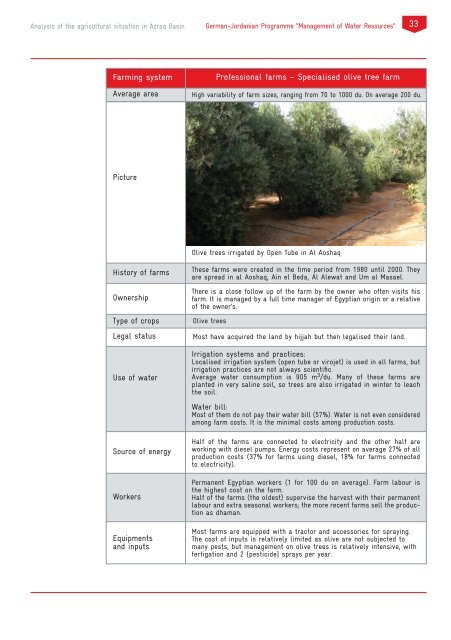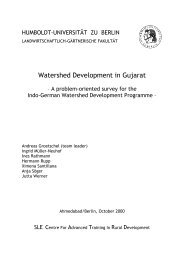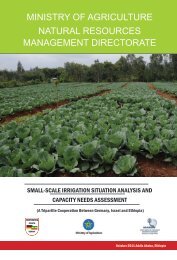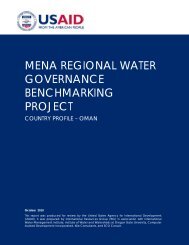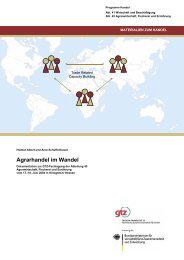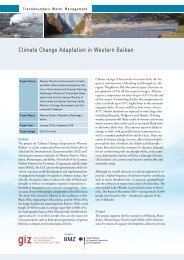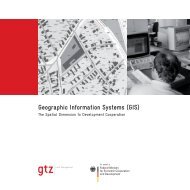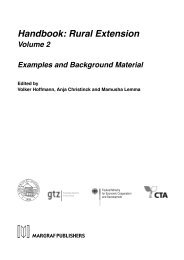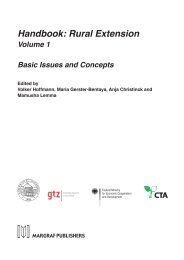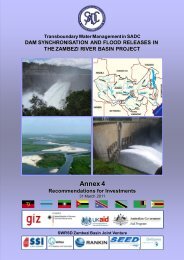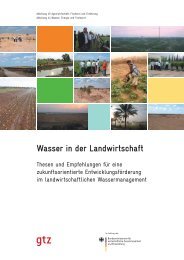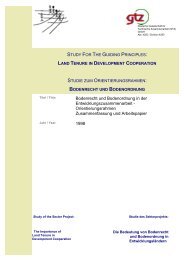Farming in the - WordPress.com
Farming in the - WordPress.com
Farming in the - WordPress.com
You also want an ePaper? Increase the reach of your titles
YUMPU automatically turns print PDFs into web optimized ePapers that Google loves.
Analysis of <strong>the</strong> agricultural situation <strong>in</strong> Azraq Bas<strong>in</strong><br />
German-Jordanian Programme “Management of Water Resources”<br />
33<br />
<strong>Farm<strong>in</strong>g</strong> system<br />
Average area<br />
Professional farms – Specialised olive tree farm<br />
High variability of farm sizes, rang<strong>in</strong>g from 70 to 1000 du. On average 200 du.<br />
Picture<br />
Olive trees irrigated by Open Tube <strong>in</strong> Al Aoshaq<br />
History of farms<br />
Ownership<br />
Type of crops<br />
Legal status<br />
Use of water<br />
These farms were created <strong>in</strong> <strong>the</strong> time period from 1980 until 2000. They<br />
are spread <strong>in</strong> al Aoshaq, A<strong>in</strong> el Beda, Al Alewat and Um al Masael.<br />
There is a close follow up of <strong>the</strong> farm by <strong>the</strong> owner who often visits his<br />
farm. It is managed by a full time manager of Egyptian orig<strong>in</strong> or a relative<br />
of <strong>the</strong> owner’s.<br />
Olive trees<br />
Most have acquired <strong>the</strong> land by hijjah but <strong>the</strong>n legalised <strong>the</strong>ir land.<br />
Irrigation systems and practices:<br />
Localised irrigation system (open tube or virojet) is used <strong>in</strong> all farms, but<br />
irrigation practices are not always scientific.<br />
Average water consumption is 905 m 3 /du. Many of <strong>the</strong>se farms are<br />
planted <strong>in</strong> very sal<strong>in</strong>e soil, so trees are also irrigated <strong>in</strong> w<strong>in</strong>ter to leach<br />
<strong>the</strong> soil.<br />
Water bill:<br />
Most of <strong>the</strong>m do not pay <strong>the</strong>ir water bill (57%). Water is not even considered<br />
among farm costs. It is <strong>the</strong> m<strong>in</strong>imal costs among production costs.<br />
Source of energy<br />
Workers<br />
Equipments<br />
and <strong>in</strong>puts<br />
Half of <strong>the</strong> farms are connected to electricity and <strong>the</strong> o<strong>the</strong>r half are<br />
work<strong>in</strong>g with diesel pumps. Energy costs represent on average 27% of all<br />
production costs (37% for farms us<strong>in</strong>g diesel, 18% for farms connected<br />
to electricity).<br />
Permanent Egyptian workers (1 for 100 du on average). Farm labour is<br />
<strong>the</strong> highest cost on <strong>the</strong> farm.<br />
Half of <strong>the</strong> farms (<strong>the</strong> oldest) supervise <strong>the</strong> harvest with <strong>the</strong>ir permanent<br />
labour and extra seasonal workers; <strong>the</strong> more recent farms sell <strong>the</strong> production<br />
as dhaman.<br />
Most farms are equipped with a tractor and accessories for spray<strong>in</strong>g.<br />
The cost of <strong>in</strong>puts is relatively limited as olive are not subjected to<br />
many pests, but management on olive trees is relatively <strong>in</strong>tensive, with<br />
fertigation and 2 [pesticide] sprays per year.


